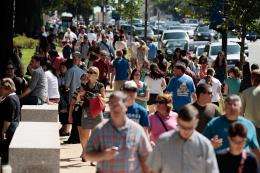Why East Coast earthquakes travel so far

A rare 5.8 earthquake that rattled the eastern United States on Tuesday was felt over a wide area from Toronto, Canada down to Georgia due to the hard, brittle quality of the ground, experts said.
The quake that struck mid-afternoon near Richmond, Virginia was the strongest in the state since 1897, and shook the eastern seaboard for some 30 seconds, sparking a wave of panic among residents.
"Earthquakes of this magnitude are unusual in your area, but the fact that you shook so hard and the event was actually some distance from you is not unusual," Thomas Jordan, director of Southern California Earthquake Center based at the University of Southern California, told AFP by phone.
The outer rocky shell of the Earth, known as the lithosphere, is colder on the East Coast than in California, which is well known for experiencing frequent earthquakes.
"So when something shakes, it is like hitting a bar of steel, it rings pretty well. Whereas on the West Coast, the rocks are higher temperature and it is more like hitting something quite a bit softer," he said.
Lucy Jones, a USGS spokeswoman, said the West Coast crust is broken up by active faults so it "doesn't do as good of a job of transmitting the energy."
"On the East Coast, you have this old, hard, cold crust that does a lovely job of transmitting the waves like a solid bell," she said on CNN, so that an earthquake "can definitely be felt hundreds of miles away."
The US East Coast has plenty of fault lines, but they are ancient, and are inside a creaky plate that is under pressure from being jostled and pushed by other plates, experts said.
Occasionally, pressure builds up and stresses will be released in earthquakes, like the one on Tuesday.
"They are faults that used to be very active faults hundreds of millions of years ago, unlike the faults on the West Coast... (that) are active today," Jordan said.
Jack Boatwright, a seismologist with USGS, told AFP that one aftershock of 2.8 magnitude was recorded in the hour following the quake.
Other parts of the world that are similar to the US East Coast in terms of earthquake dynamics would include India, as well as some parts of Russia and Australia, he added.
"In India, that large triangle is relatively old, so we think that it conducts energy similarly," he said.
Other differences between East and West Coast quakes are the sounds they make -- residents of California are less likely to hear banging associated with a big quake unless they are very near the epicenter, he said.
"On the East Coast you might hear it many kilometers (miles) away, so don't distrust the people who said they heard it," Boatwright said.
Jordan added that the likelihood of a bigger quake in the near future was minimal.
"There is a small probability that this could be the first of a set of earthquakes and there could a larger earthquake coming, but the chances of that are small, about three to five percent."
On the US East Coast, where brick and wood buildings are not typically built to withstand shaking, a local official in Virginia said they were investigating calls of structural damage.
Washington's National Cathedral reported "significant damage," with parts of three of the central tower's four pinnacles, its uppermost spires, having fallen off. No one was injured by the falling debris.
"On the East Coast you have a lot of structures that, since they haven't been built to withstand earthquakes, don't do a very good job if they are actually shaking," said Jordan.
Any damage that occurs is typically close to the epicenter in such quakes, and the area where the quake struck was not a heavily populated town center.
(c) 2011 AFP


















